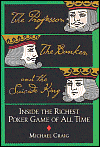 Hardcover: 288 pages
Hardcover: 288 pages
Publisher: Warner Books (June 2, 2005)
Language: English
ISBN: 0446577693
Average Customer Review: 4.5 (out of 5)
I know I’m a little late to the game with this review but I finally got around to reading Professor, the Banker, and the Suicide King, The : Inside the Richest Poker Game of All Time by Michael Craig and I’ve got to give it a big thumbs-up. The book is well written, entertaining, and filled with enough interesting nuggets of information that you have a hard time putting it down.
First off, it’s not a poker strategy book. It’s the true tale of the top poker pros in the world taking on a multi-billionaire from Texas, Andy Beal, who becomes obsessed with beating the game. What Andy lacks in experience he attempts to compensate for by continuously raising the stakes in order to take the pros out of their comfort level. In the end, he gets the stakes up to $100,000/$200,000 and it certainly unsettles some of the top pros who struggle to keep ahead of Beal.
For anyone thinking that Beal would have to be crazy to try to outplay the world’s best poker players, one has to consider that Beal is a self-made success. He was a man who came from humble beginnings and built a fortune by making smart decisions. He also has a history of becoming fixated on a hobby to the point where he develops a deep level of expertise as was demonstrated when, with no formal mathematics background, began to play around with mathematics. He eventually developed what would come to be known as the Beal Conjecture in 1997 and has posted a $100,000 prize to anyone who can provide either a proof or counterexample to his conjecture. So far, the prize remains unclaimed.
On the other side of the table from Beal were the best poker players in the world. Barry Greenstein, Howard Lederer, Doyle Brunson, Todd Brunson, Jennifer Harman, Johnny Chan, Ted Forrest, Chip Reese, and others. Each played Beal in heads-up sessions where millions of dollars would change hands. Some did well against the amateur while others could never seem to come out ahead against him. Howard Lederer seemed to have Beal pegged better than the rest and Beal became so concerned about this that he negotiated terms that would ensure he wouldn’t have to play against Lederer.
In a sense, the entire book is about Beal’s ability to negate the edge the pros had. While the pros had more experience, Beal could partially negate that by raising the limits high enough that they were uncomfortable. When he thought that he was giving away too much information by the way he played his cards, he developed all sorts of ways to randomize how long he took between looking at his cards and acting. He even installed a device strapped to his leg that would vibrate every few seconds as a reminder. In the end, many of the pros became concerned that over their many sessions he may have narrowed their edge to such a slim advantage that a lucky run of cards by Beal could bust them.
In all of this are some pretty valuable lessons for poker players. First, it’s hard work. A billionaire certainly has plenty of interests that compete for his time yet the lengths that Beal goes to, to eliminate the edge the pros have on him borders on obsessive. Second, few players wake up one day with a gift for poker. Howard Lederer was so broke at one point he slept on park benches and did odd-jobs during the day to make enough money so he could play poker at night. And for many years, he lost all his money every night and had to start over the next day. To become the best at anything, one needs to commit to it fully and accept no other outcome. Success rarely comes easy and in poker, the school of hard knocks is an essential prerequisite.
Thanks for the kind words, and I’m glad you enjoyed it. Please introduce yourself to me at the Blogger’s conference, Bill. I’ll be speaking about, among other things, how I found out about this remarkable story, why Ted Forrest is a terrible loan shark, and the contents of Mike Matusow’s refrigerator.
M
I read this book. Interesting that it is called ‘comfort level’. Variance is variance, the pros had a relatively small bankroll. Beal was just trying to bully the pros with his big stack. No skill in that. He should play them in NL. He’d be broke quickly.
That book sounds really interesting. I would love to read this book… The thought of raising the stakes so high that pro’s were out of their comfort level is insane. Great right up Bill, I am definately going to look into getting this book..